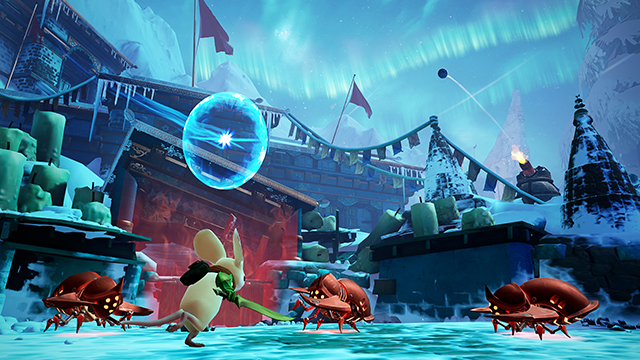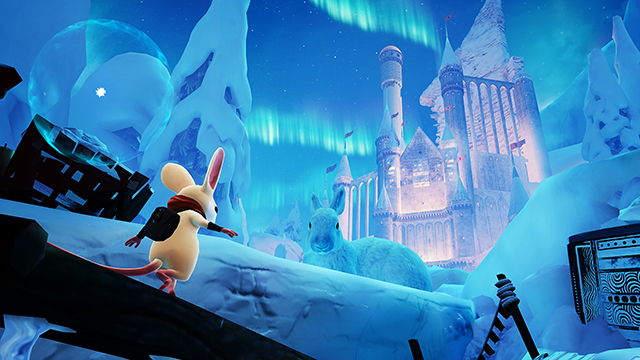Moss Book II kicked off Sony’s most recent State of Play, which is not only atypical for a virtual reality game, but also odd because it’s technically a PlayStation 4 game, too. It’s even on one of the weaker VR helmets. But even with aging technology, Polyarc is still amped to be working with the hardware for the upcoming sequel to its beloved mouse-led platformer.
Part of this excitement stems from Polyarc’s will to return to Moss’ world to tell more stories within the universe established in the first game. The first game hinted at some bigger problems with the world at large, which is something Book II is tackling. But Polyarc is also interested in VR’s capability to tell a more intimate story.
Design Director Josh Stiksma said the team received letters from satisfied players who felt like Quill, the rodent protagonist, changed their lives or changed how they approached it. Stiksma laid that responsibility at the feet of virtual reality, as it showed the strengths of the medium. That exact sort of bond isn’t as easily replicated in a more traditional gaming experience given the inherent distance between player and protagonist. He said the studio was even surprised at how much it resonated with people.
“It’s a new medium,” Stiksma said. “It’s sort of like a new gold rush in a way where all of this opportunity is here but you have to utilize it correctly if you want to be successful. One of the things that drove us to VR was the amazing sense of immersion for telling stories. And I think that is one of the reasons why we’re still really excited to push on that front because we have a lot of people who are excited about telling stories, creating immersive worlds, and bringing players to those worlds and making them smile while they’re in them. We think it’s really a medium to do that.”

Moss Book II is further pushing on some of those ideals Polyarc established in the first game from the implementation of American Sign Language to level design. The team is pushing how it is approaching physical interactions as those are what helped bond players to Quill in the first place. Comfort within virtual reality is also a big deal, a company pillar that the whole game stands on. Spatial awareness is also important as the studio wants to improve in that area as it is looking to create bigger areas that are still comfortable to interact with. It was something Polyarc first tested in Twilight Garden, a huge free update that came out a year and a half after launch, and felt it was successful.
Polyarc also tested out some new weapon abilities, which will be more fully realized here. Stiksma highlighted the hammer seen in the trailer, the tool so heavy that little Quill can hardly hold it. The aim is to not just make these armaments of destruction, but also useful in puzzles and traversal, too. Charging Quill’s weapon, as seen in the DLC, has now been expanded to include interacting with the environment. The debut trailer showcases this ability as users can reach out and grab a vine to make a bridge. Stiksma didn’t list other means of interaction, but did emphasize that these were more important this time around and there will be many “different interactions that feel different.”
VR isn’t just a means to explore new game mechanics or expand on existing ones as Polyarc wants to double down on story this time around as well. The player’s bond with Quill is “of utmost importance” so, in order to bring it to the next level, the writing team is aiming to weave it into the narrative structure and “[target] a broader range of emotion.” Polyarc wants players to feel the triumph of success, uncertainty, heartbreak, and a host of other feelings and the magic of VR, according to Stiksma, is what makes it possible and the potentially stronger. The developer knows it can affect players in such ways, given the feedback from the first game and that feedback inspired them to step it up.

But to some, PSVR might not be the exact headset within that medium to realize those goals. It’s got more wires than most and, again, it isn’t as strong as other headsets on the market; a stark difference that grows even more stark by the day thanks to the new consoles and PC headsets. The next PlayStation VR headset is still at least a year away so it wouldn’t be all that bizarre for Polyarc to want to wait and jump in on whatever Sony is cooking up.
Despite the reasons to move forward, Stiksma is still pleased with the current tech. The looming arrival of more powerful VR headsets might be enticing to him for a multitude of reasons, mainly having two controllers and fewer wires. But, as Stiksma says, there will always be games to make in the future.
“VR has advanced but the one thing we’re trying to do is really make the best of current hardware,” he said. “And not just use it as a constraint, but say, ‘Hey, what’s something that we can still push on this and still make the experience feel better and interactive?’”
He elaborated, stating he felt the team had Sony’s support.
“We are really excited to make a second game,” he said. “I think a lot of it comes down to us using the technology that is there to get it out there. We could wait but we are really excited to get this game in the hands of players now. New technology is going to continue to come out and we feel extremely supported by Sony to be releasing on PSVR. We’re also excited for future opportunities because we want the game to be enjoyed by as many people as possible.”
Polyarc already made a well-received VR platformer once on PSVR — the original sits at an 86 on OpenCritic — so it’s not unheard of for the studio to do the same thing again. Moss Book II appears to have a lot of the same charm as the original, but with a more focused touch. While it remains to be seen how this follow-up with shape up, sometimes better technology isn’t required to make a better game.










